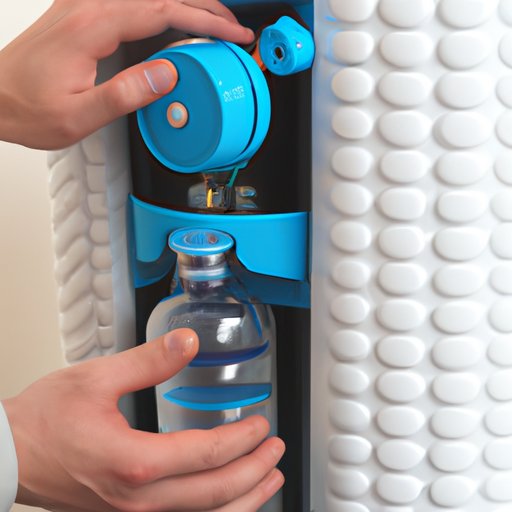Introduction
Water softening is the process of removing minerals such as calcium and magnesium from hard water. These minerals can build up in pipes, appliances, and fixtures and cause damage over time. A water softener is a device that is used to remove these minerals from water. The purpose of this article is to explain the science behind water softening and to provide an in-depth guide to understanding how does water softener work.
Explaining the Science Behind Water Softening
In order to understand how a water softener works, it is important to first understand what causes hard water. Hard water occurs when there are large amounts of minerals, such as calcium and magnesium, dissolved in the water. These minerals are not harmful to drink, but they can cause problems when they build up in pipes, fixtures, and appliances. This buildup can lead to clogged pipes, decreased water pressure, and reduced efficiency of water-using appliances.
The process of water softening involves the removal of these minerals from the water supply. This is usually done using a device called a water softener, which uses a combination of ion exchange and filtration to remove the minerals from the water. The softened water is then sent back out into the house.
How Does a Water Softener System Work?
A water softener system consists of several components, including a resin tank, a brine tank, and a control valve. The resin tank contains small beads of plastic that act as a filter. As water passes through the resin tank, the beads trap the minerals and hold them in place. The brine tank contains a solution of salt and water, which is used to clean the beads of mineral deposits.
The control valve is responsible for controlling the flow of water through the system. When the control valve senses that the water has become too hard, it triggers the brine tank to flush the beads with the salt solution. This flushes away the mineral deposits, allowing the water to pass through the system unencumbered.

The Benefits of Installing a Water Softener
Installing a water softener system can have many benefits, both for your home and for your health. Softened water can improve the quality of your drinking water, as well as the water used for bathing and cleaning. Soft water can also help extend the lifespan of your appliances, as the minerals in hard water can cause corrosion and damage to pipes and fixtures.
Soft water can also be beneficial for your skin and hair. The minerals in hard water can leave a residue on the skin and hair, which can lead to dryness and irritation. Using softened water can help reduce this irritation and leave your skin and hair feeling softer and healthier.

Troubleshooting Common Water Softener Problems
Even with regular maintenance, water softeners can experience some common problems. One of the most common issues is a low salt warning. This indicates that the salt levels in the brine tank are running low and need to be replenished. This can happen if the system has been running for an extended period of time or if the water consumption in the house is high.
Another common problem is high water pressure. This can be caused by a faulty pressure switch or a blocked sediment filter. If the pressure is too high, it can cause damage to the system and reduce its efficiency. Finally, poor water quality can be caused by a variety of factors, including worn out resin beads or a malfunctioning control valve.

Types of Water Softeners and Their Differences
There are several different types of water softeners available on the market. The most common type is a salt-based water softener, which uses salt to remove the minerals from the water. Another type is a salt-free water softener, which uses a process called catalytic conversion to soften the water without the use of salt. Finally, there are magnetic water softeners, which use magnets to attract and remove the minerals from the water.
Tips for Maintaining Your Water Softener System
Maintaining your water softener system is essential for keeping it running efficiently. One of the most important things you can do is regularly check the salt levels in the brine tank. This will ensure that the system is able to flush out the minerals effectively. You should also monitor the water pressure in your home, as this can affect the performance of the system.
Finally, you should clean the system regularly. This will help prevent any buildup of debris or minerals, which can reduce the efficiency of the system. Cleaning the system is relatively simple and can be done by flushing the system with a solution of salt and water.
Conclusion
Water softening is a process that removes minerals like calcium and magnesium from hard water. A water softener system consists of several components, which work together to soften the water. Installing a water softener can have many benefits, including improved water quality, longer lifespan of appliances, and healthier skin and hair. There are several types of water softeners available, and it is important to maintain the system regularly in order to keep it running efficiently.
(Note: Is this article not meeting your expectations? Do you have knowledge or insights to share? Unlock new opportunities and expand your reach by joining our authors team. Click Registration to join us and share your expertise with our readers.)
